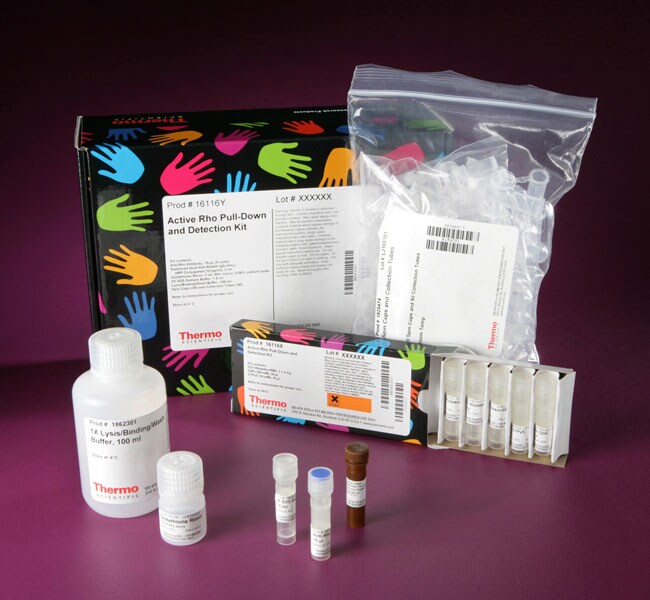
The Thermo Scientific Pierce Active Rho Pull-Down and Detection Kit enables selective enrichment and detection of GTP-bound Rho GTPase through specific protein interaction with the Rhotekin protein-binding domain.
The Active Rho Pull-Down and Detection Kit includes purified GST-Rhotekin Rho-binding domain (RBD), glutathione agarose resin, positive and negative controls (GTPγS and GDP, respectively), lysis/binding/washing buffer, anti-Rho antibody, secondary antibody, sample buffer, spin columns and collection tubes. The kit was validated using lysates from NIH 3T3 cells, a cell line known to have robust Rho activity.
Features of the Active Rho Pull-Down and Detection Kit:
• Highly sensitive and accurate—optimized reagents, specific pan anti-Rho antibody and Western blot procedure ensure accurate controls and semi-quantitative results
• Validated—functionally tested for Rho detection to ensure quality and performance
• Compatible—effective with a variety of cell types from mouse, rat and human sources
Applications:
• Follow activation of Rho GTPase during cell differentiation, migration, division and cytoskeletal rearrangement
• Study the activation of Rho during stress fiber formation
• Monitor Rho activity after stimulation with growth factors
• Screen small-molecule inhibitors for their effects on Rho activity
The Active Rho Pull-Down and Detection Kit was validated for function and specificity for active Rho using cell lysates treated with GTPγS to activate endogenous Rho and compared to GDP-treated lysates to inactivate the small GTPase. GTPγS treatment traps Rho in the GTP-bound form (active), resulting in a strong signal when endogenous Rho is present. GDP treatment pushes Rho into the GDP-bound state (inactive), resulting in little to no signal, regardless of Rho protein levels. This kit is optimized for Western blot detection using an HRP-conjugated secondary antibody (included) and Thermo Scientific SuperSignal West Pico Chemiluminescent Substrate (available separately, Part No. 34080). The kit contains sufficient components for 30 pull-down assays.
Kit components can also be used for immunofluorescent staining. Neuronal NS-1 cells were stimulated with NGF to study the spatial distribution of active Rho using the GST-RBD protein and anti-Rho antibody supplied in the kit.
Rho Background:
Rho family GTPases serve many cellular functions, including cell signaling, transcriptional regulation and organization of the actin cytoskeleton. This family of GTPases comprise Rho (RhoA, RhoB, and RhoC), Rac (Rac1, Rac2, Rac3, and RhoG), Cdc42 (Cdc42 and G25K), Rnd (Rnd1, Rnd2, and RhoE/Rnd3), RhoBTB family and the Miro family. These GTPases enable signal transduction from the plasma membrane to the cytosol through GPCR, tyrosine kinase, cytokine and adhesion receptors. Attachment to the plasma membrane is accomplished through geranylgeranyl lipid modifications at the carboxy-terminus of the protein. Signal transduction through Rho GTPases results in the reorganization of actin into stress fibers and the formation of focal adhesions. RhoA is localized to the cytosol and plasma membrane, while Rho B is localized to the plasma membrane and membrane vesicles. Like RhoA, RhoC is cytosolic, although it localizes to perinuclear regions.
The Rho GTPases interact with GEF, GAP, GDI and effector proteins for signal transduction. There are over 30 mammalian GEFs for the Rho GTPases, and each GEF contains a DBl homology domain for the nucleotide exchange reaction, a pleckstrin homology domain and additional specific domains for protein-protein interactions. The Rho Gap proteins accelerate the hydrolysis of GTP, and the GDI proteins enable translocation of the Rho GTPases between the cytoplasm and membrane and inhibit the GDP/GTP exchange by Rho GEFs. The GEF and GDI interaction with Rho and the Gα subunit is necessary for signal transduction through GPCRs. Some of the effector proteins include p160 Rho kinase, a serine/threonine kinase involved in stress fiber formation, p140mDia, which triggers reorganization of the actin cytoskeleton, and Rhotekin, a serine/threonine kinase scaffold protein that mediates signaling to activate NF-κB. The Rho family GTPases can work agonistically during cell signaling and and antagonistically during differentiation.
More Product Data
• Measure activation of small GTPases via their specific downstream effectors
• Detection and localization of active GTPases in neuronal cell differentiation
| Code | Description |
|---|---|
| 16116 | Catalog Number: 16116 |

